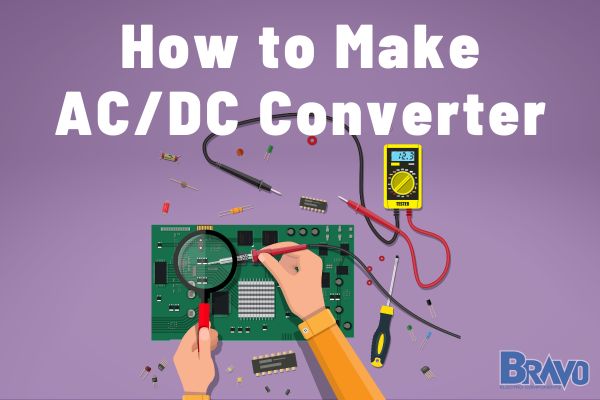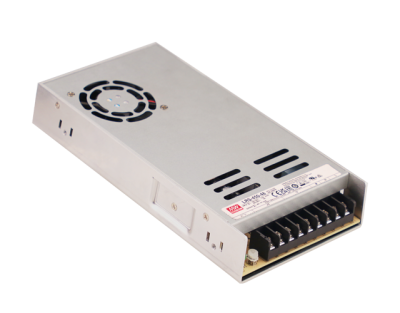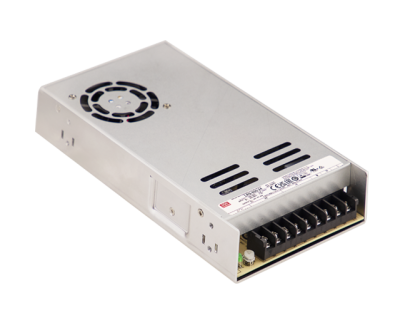
Converting AC to DC is a common challenge in household applications and industrial use cases alike. An AC to DC converter streamlines and simplifies this complex, convoluted process so you don’t even have to think about it.
But, what if you want to learn how to make AC to DC converter rather than buying one? Is it possible? Perhaps more importantly, is it worth the time and trouble?
We’ll weigh the pros and cons of the DIY AC to DC converter approach and walk you through making an AC to DC converter if you decide this is the right approach for you.
The truth is, though, you’re way better off buying a professional unit from a trusted supplier like Bravo Electro - our AC/DC power supplies are sourced from the most trusted power supply manufacturers in the industry so you can rest assured you’re getting a safe, reliable, efficient device with none of the hassle!
What is an AC to DC Converter?
Before we teach you how to make AC to DC converters, let’s talk about the role these play in the world of electricity.
An AC to DC converter, often termed a rectifier, is a device specifically designed to transform alternating current (which reverses direction periodically) into direct current that flows consistently in a single direction.
This transformation is not just a switch of current direction but a restructuring of energy that allows devices and machinery to operate more efficiently and consistently.
Fundamental Principles of Converting AC to DC
At the heart of this conversion process lies the principle of rectification. Rectifiers utilize electronic components, such as diodes, which permit the flow of current in only one direction.
Only half of the wave (positive or negative) is allowed to pass when AC flows through a diode depending on the diode's orientation. There are two primary modes of rectification:
- Half-wave Rectification: This method uses a single diode, allowing only one half of the AC wave to pass through, while the other half is blocked. It's a less efficient method as half of the AC's potential is unused.
- Full-wave Rectification: Using four diodes in a bridge configuration, it captures both halves of the AC wave, converting the negative half into positive, leading to a more efficient use of the AC input.
Applications for an AC to DC Converter
AC to DC converters can be used for everything from powering your entertainment system to fueling industrial operations.
Let’s address a common question real quick - is house electric AC or DC? House electricity comes from the grid in the form of AC current. It then needs to be converted to DC current to be used for your devices. The same is true in industrial applications. That being said, here are the most common use cases for a DIY AC to DC converter:
- Motor Drives: Many industrial motors require a steady DC supply for precise speed and torque control. A converter ensures these motors receive consistent power, eliminating fluctuations.
- Control Systems: For systems that need a stable voltage power supply, like programmable logic controllers (PLCs), AC to DC converters are indispensable.
- Battery Charging: Industrial batteries, used in backup systems or forklifts, require DC for charging. Converters ensure these batteries are charged efficiently and safely.
- Instrumentation: Precision instruments, such as oscilloscopes or voltmeters, demand a stable DC supply to ensure accuracy and reliability in measurements.
The need for an AC to DC converter is undeniable. The question is, should you learn how to make AC to DC converter or save yourself the time and trouble by purchasing a professional device at Bravo Electro?
Can You Make an AC to DC Converter?
In an era of increasing DIY enthusiasm, it's natural to question: is a DIY AC to DC converter feasible? Technically, yes.
With a fundamental understanding of electronics, one can assemble a rudimentary converter. But, like many things, while it's possible doesn't necessarily mean it's advisable for every scenario. We’ll weigh the pros and cons below.
DIY Possibilities
Creating a simple rectifier can be an educational experience for hobbyists or those with a penchant for tinkering.
Basic converters can be fashioned using a few diodes, capacitors, and perhaps a transformer, depending on the desired voltage output.
Such projects can serve as a learning platform, illuminating the nuances of electrical conversion. That being said, this is never something we recommend for industrial use cases. Here’s why…
Challenges in DIY
The DIY AC to DC converter route is riddled with pitfalls, and these can all be avoided by spending a bit more to purchase a professional device. Some of the challenges you may encounter include:
- Safety Concerns: Working with electricity, especially AC, comes with inherent risks. One misstep can lead to electrical shocks or even fires.
- Complexity: While the concept seems straightforward, achieving efficient and stable conversion is intricate. The risk of oscillations, overheating, or unintended voltage spikes is real.
- Reliability: A homemade converter may not offer the consistent performance demanded by professional or industrial applications. Intermittent issues can plague such systems, leading to more significant problems downstream.
- Time and Effort: Sourcing components, understanding schematics, and the actual assembly can consume substantial time. For professionals, time equates to money. Is the investment worth the potential return?
The Appeal of Buying a Professional Unit
Opting for a professional AC to DC converter from a trusted source like Bravo Electro offers several undeniable advantages. The first and most obvious is dependability. These units are designed with precision, ensuring consistent performance.
You’ll also enjoy superior safety standards on these units that have strict power supply certifications and power supply ratings. This provides you with peace of mind.
But, they also have a higher power supply efficiency rating. Professional converters are optimized for minimal energy loss, ensuring your operations run at peak efficiency.
Perhaps the biggest benefit to buying a unit instead of attempting to build one, though, is the support you gain along the way. Purchasing from a trusted supplier means access to expert advice, warranties, and often post-purchase support.
How to Make AC to DC Converter: Step-by-Step Guide
The appeal of DIY AC to DC converter creation is evident, but it’s clear that the downside outweighs the upside - at least for most individuals. Nevertheless, we’ll walk you step-by-step through how to make AC to DC converter below if your heart is set on this project.
Materials Needed
You may be caught off guard when you discover just how many different materials and components go into making an AC to DC converter DIY. While you may have thought you were going to save money on the power supply cost, these inputs can quickly add up:
- Transformers: Serves to step down the input voltage, making it manageable and safer.
- Diodes: Essential for rectification, converting AC's alternating nature to a unidirectional DC current.
- Capacitors: Helpful in filtering out ripples and providing a smoother DC output.
- Resistors: Aid in managing the current flow and can provide a safety buffer.
- Breadboard or PCB: For assembling and connecting components.
- Wires and Connectors: Essential for interlinking the components.
Armed with all these components you’re reading to start the project. Let’s offer a quick word on safety before we get into the building process.
Safety Considerations
Safety is top of mind when working with electrical components. Ensure your workspace is clean, well-lit, and of course, non-conductive. It’s also a good idea to consider wearing rubber gloves and safety goggles to protect against accidental sparks or debris.
Always disconnect from any power source while assembling the device. Familiarize yourself with each component's purpose and specifications. Knowledge is the first step towards safety.
Building Process
Now, let’s get into how to make AC to DC converter. The process is as follows:
- Transformer Setup: If your AC source voltage is higher than your desired DC output, incorporate a transformer into your design. This will step down the AC voltage to a more appropriate level.
- Rectification: Set up diodes in a bridge configuration. This bridge will convert the AC, whether stepped down or directly from the source, into a pulsating DC once the system is powered on.
- Smoothing: After the diode bridge, connect capacitors. They help in converting the pulsating DC to a smoother DC waveform.
- Fine-Tuning (if necessary): Depending on your needs, utilize resistors or voltage regulators to adjust and stabilize the output DC voltage.
Testing and Validation
Before connecting to any device, use a multimeter to check the output voltage and ensure it aligns with your intended value.
You can also connect a load, like a DC bulb or motor, to see if the converter can handle real-world applications. Allow the system to run for extended periods, monitoring for any signs of overheating or instability.
We have tips on trouble shooting power supplies if your DIY AC to DC converter isn’t working how you’d hoped. You can also learn about maximizing your power supply lifespan, how to tell if power supply is failing, how to tell if your PSU is too weak, power supply topologies, and more in our blog.
But as you can see, the perplexing process of trying to make your own AC to DC converter DIY is fraught with complexities. Wouldn’t it be nice to bypass all these headaches and just by a professional unit from a trusted brand?
Save Yourself Time While Avoiding Costly Mistakes - Get an AC-DC Converter at Bravo Electro!
Opting for a professional unit is the wise choice in industrial settings where precision, longevity, and performance can't be compromised. Enter Bravo Electro, your partner in delivering top-tier converters tailored to your needs.
Why Shop With Us?
In an industry where even a minor malfunction can cause significant setbacks, Bravo Electro's units are synonymous with trust. We’ve rigorously vetted and curated our catalog from top brands like MEAN WELL so you know you’re getting a reliable device every time you shop with us.
We’ve also worked to develop a vast catalog of power supply types, from a modular power supply to din rail mount power supply, DC/DC converter, external power supply, rack mount power supply, and more.
You can choose from 12v power supply, 24v power supply, 48v power supply, or even high voltage power supplies for the most robust industrial use cases.
But, if one of our many standardized units doesn’t meet your needs, we can offer custom power solutions. Our electrical engineers are on standby ready to go over your requirements and bring a custom AC to DC converter to life.
Speaking of support, we have a world-class customer service team that can help you navigate the uncertainties of what power supply you need - get in touch today or learn more about choosing the right converter below!
Tips on Choosing the Right Converter
First, gauge the scale of your operations. Are you catering to a massive system or just a single apparatus? The capacity of your converter should align with your requirements.
Look for converters that boast high efficiency. They not only save on energy costs but also ensure a longer lifespan for connected devices due to consistent voltage outputs.
If your operations are in an area with frequent power fluctuations or surges, opt for converters that come with built-in surge protectors or stabilizers.
Always consider potential expansion. It's wiser to invest in a converter that can handle a bit more than your current needs, providing room for growth.
Ultimately, the best way to choose the right converter is to simply reach out and let us provide a personalized recommendation. Get in touch as we wrap up this guide on how to make AC to DC converter!
Wrapping up Our Guide on How to Make AC to DC Converter
We know you came here to learn how to make AC to DC converter, but as you can see, the intricacies of creating an AC to DC converter can be a challenge that distracts you from more important things. It also opens the door to costly errors that interrupt your operation down the road.
While crafting one's own unit offers a sense of accomplishment, it's crucial to weigh the challenges against the benefits. Professional AC-DC converters from Bravo Electro are designed with accuracy, ensuring reliability and performance at its pinnacle. Why embark on a complex process when a trusted solution is at your fingertips?
Our blog has additional resources on topics like the difference between AC and DC, how to convert DC to AC, what is an AC adapter, PSU installation, and more. Otherwise, it’s time to bring your DIY AD to DC converter to life or shop with us.
From enclosed power supplies to medical grade power supplies, switching vs linear power supplies, UL listed power supplies, and more - we’ve got it all for you at Bravo Electro.









